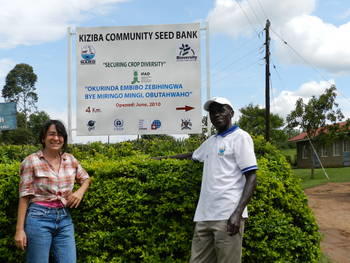Bean biodiversity bugs pests

In light of the UN-declared International Year of Pulses, Bioversity International scientist Devra Jarvis blogs about the benefits that many bean varieties have on yields.
By Devra I. Jarvis, Principal Scientist, Bioversity International
The common bean is an unsung hero, and especially important in East and Central Africa and parts of Latin America. As well as improving the fertility of the soil in which it grows and providing farmers with a reliable income stream, it is the most important plant-based protein source for the people of Uganda, providing between 20 and 25% of the protein of the local diet.
In many cases, however, bean yields are lower than they could be. This presents clear opportunities for beneficial interventions and — especially pertinent in this International Year of Pulses — demonstrates the value of considering the full potential of pulses.
In Uganda, for example, bean yields are consistently 20% lower than their possible levels, largely because of damage by pests and diseases. Some parts of Uganda bean yield losses of up to 25% as a result of attacks by Bean Fly, Angular Leaf Spot (ALS) or Anthracnose. Research undertaken by Bioversity International shows that when farmers grow three or more bean varieties in their fields their crops sustain significantly less damage than those on plots with few varieties, particularly in years when there is a high incidence of disease.
In Ecuador, the picture is different. Smallholder farmers already plant their beans in mixtures and generally stick to traditional varieties (almost 90% of the beans sown in Ecuador are of traditional varieties). Despite using few or no pesticides, these farmers suffer low levels of pest and disease damage — less than 3% in 2012. Yet work with farmer groups in bean trials revealed there was nonetheless room for improvement.
Our research showed that after enhancing the bean plant mixtures by adding more varieties to the mixture than were normally used, yields increased and in some cases doubled. In fact, the yields exceeded those from both normal mixtures and commercial varieties sown. Moreover, that year was one of low rainfall, and while the enhanced mixtures outperform the normal mixtures many farmers had little or no harvest from their commercial monocultures that year.
- Read the original blog post Species diversity helps farmers reap the potential of pulses
- Discover the link between healthy soils and pulses: attend the Soils and Pulses symbiosis for life event on the 19th of April at FAO, Rome, Italy
Devra Jarvis and national partner from the National Agricultural Research Organisation (NARO) in front of Kiziba community seedbank, established in Uganda in 2010. Credit: Bioversity International/D. Jarvis
